1993 PONTIAC GRAND-AM engine overheat
[x] Cancel search: engine overheatPage 181 of 306
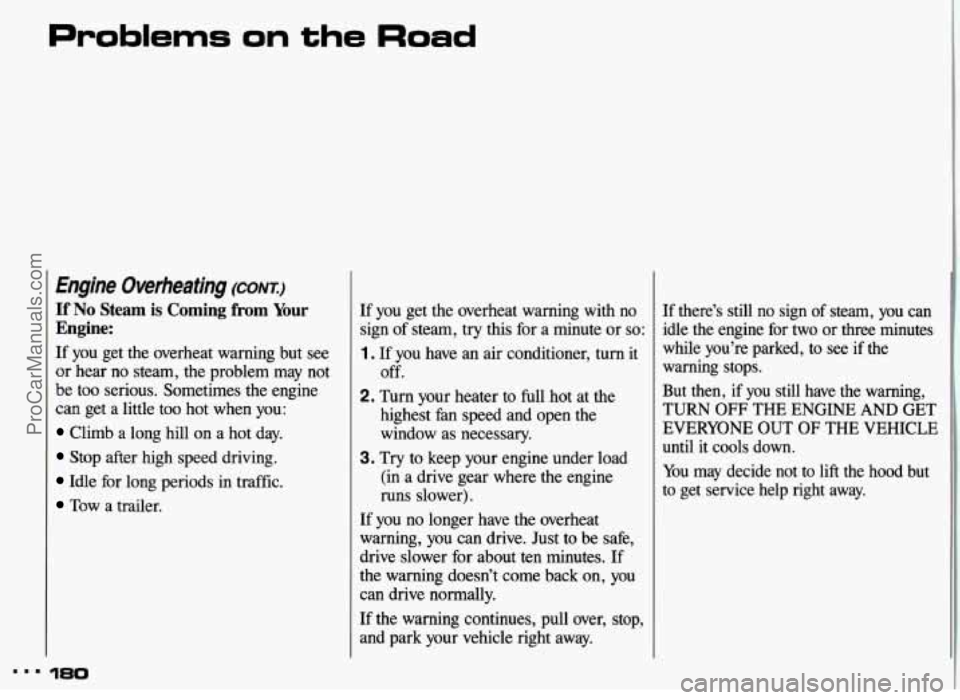
Problems on the Road
Engine Overheating (CONT)
If No Steam is Coming from Your
Engine:
If you get the overheat warning but see
or hear no steam, the problem may not
be
too serious. Sometimes the engine
can get a little too hot when you:
Climb a long hill on a hot day.
Stop after high speed driving.
Idle for long periods in traffic.
Tow a trailer.
180
If you get the overheat warning with no
sign of steam, try this for a minute or so:
1 . If you have an air conditioner, turn it
off.
2. Turn your heater to full hot at the
highest fan speed and open the window as necessary.
3. Try to keep your engine under load
(in a drive gear where the engine
runs slower).
If you no longer have the overheat
warning,
you can drive. Just to be safe,
drive slower for about ten minutes.
If
the warning doesn’t come back on, you
can drive normally.
If the warning continues, pull over, stop,
and park your vehicle right away. If there’s
still no sign of steam, you can
idle the engine for two or three minutes
while you’re parked, to
see if the
warning stops.
But then, if you still have the warning,
TURN
OFF THE ENGINE AND GET
EVERYONE OUT
OF THE VEHICLE
until it cools down.
You may decide not to lift the hood but
to get service help right away.
ProCarManuals.com
Page 182 of 306
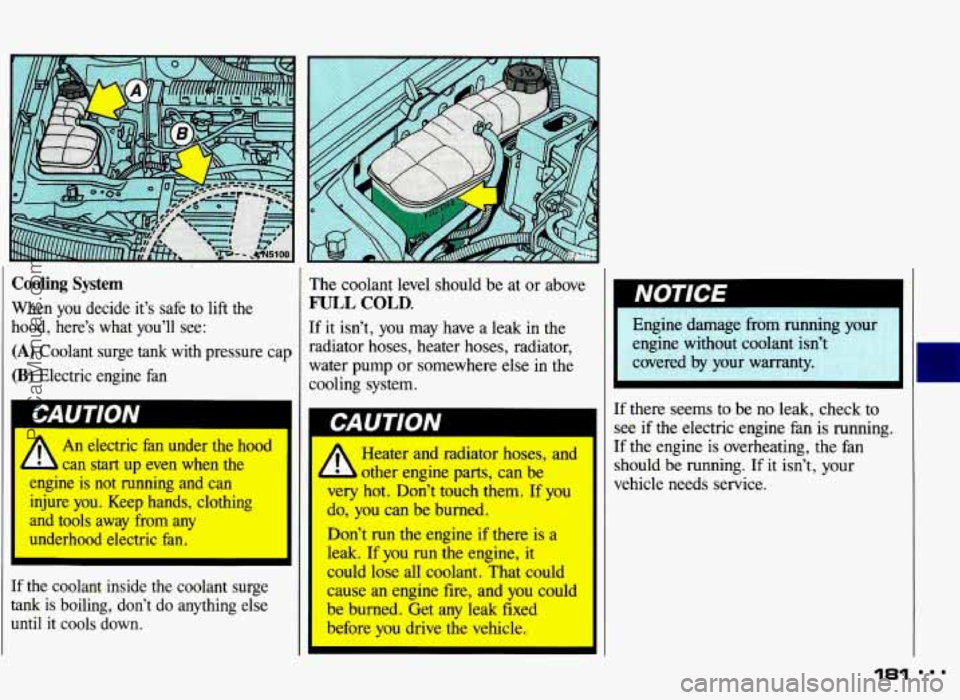
Cooling System
When you decide it’s safe to lift the
hood, here’s what you’ll see:
(A) Coolant surge tank with pressure cap
(B) Electric engine fan
bAU I IVIV
1 /r An electric fan under the hood
- b can start up even when the
engine is not running and can injure you. Keep hands, clothing
and tools away from any
underhood electric fan.
[f the coolant inside the coolant surge
tank is boiling, don’t do anything else
until
it cools down.
’he coolant level should be at or above
TJLL COLD.
f it isn’t, you may have a leak in the
adiator hoses, heater hoses, radiator,
dater pump or somewhere else
in the
ooling system.
A
Heater and radiator hoses, and
other engine parts, can be
very hot. Don’t touch them.
If you
do, you can be burned.
Don’t run the engine if there is a
leak. If
you run the engine, it
could lose all coolant. That could
cause an engine fire, and you could
be burned. Get any leak fixed
before
you drive the vehicle. Engine damage
from
runni
engine without coolant isn’
covered by your warranty.
there seems to be no leak, check
to
x if the electric engine fan is running.
C the engine is overheating, the fan
hould be running.
If it isn’t, your
chicle needs service.
181
ProCarManuals.com
Page 183 of 306

Problems on the Road
Engine Overheating (CONTJ
How to Add Coolant to the Coolant
Surge Tank:
If you haven’t found a problem yet, but
the coolant level isn’t at or above
FULL
COLD, add a 50/50 mixture of clean
water
(preferably distilled) and a proper
antifreeze at the coolant surge
tank, but
be sure the cooling system, including
the coolant surge
tank pressure cap, is
cool before
you do it. (See the Index
under Engine Coolant for more
information about the proper coolant
mix.)
182
L Steam and scalding liquids
L from a hot cooling system can
blow out and burn you badly. They
are under pressure, and if you turn
cap-evm a little-they can come
out at high speed. Never turn the
pressure cap when the cooliag
tank pressure cap, is hot. Wait for
the cooling system and coolant
you ever have to turn the pmsure
MP.
the coolant surge tank pressure
system, including the COoIant surge
surge tank pressure cap to cool if
Adding only plain water to
dangerous. Plain water, or some
other liquid like alcohol, can boil
before the proper coolant mix will.
Your vehicle’s coolant warning
system is set for the proper coolant
mix. With plain water or the
wrong mix, your engine could get
too hot but you wouldn’t get the overheat warning. Your engine
could catch fire and you or others
could be burned. Use a
50/50 mix
of
clean water and a proper
antifreeze.
k your cooling system can be I
ProCarManuals.com
Page 185 of 306
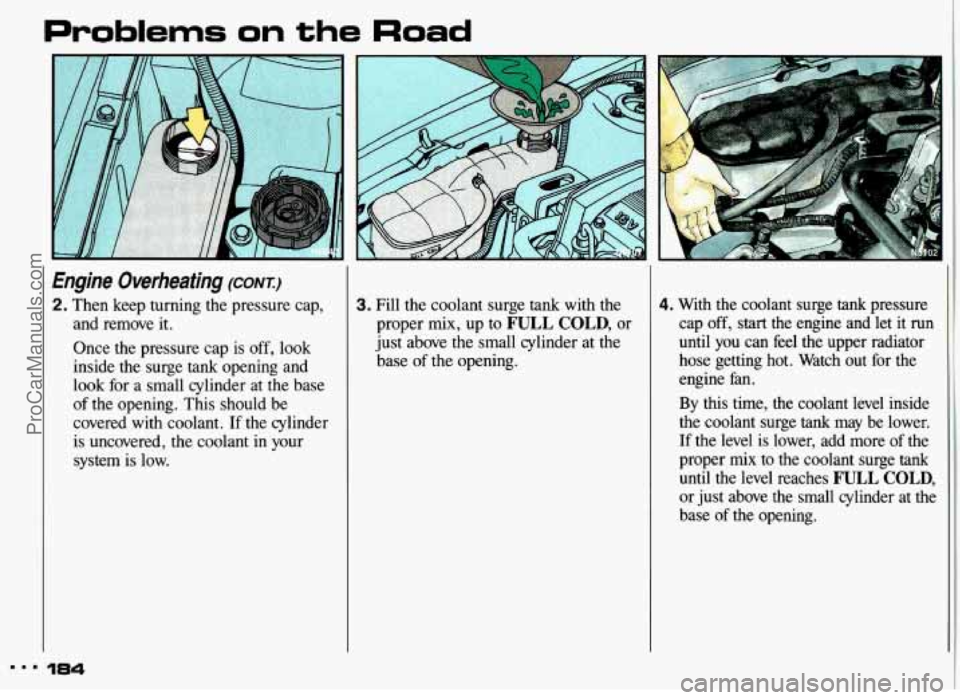
Problems on the Road
,
Engine Overheating (CONT.)
2. Then keep turning the pressure cap, and remove it.
Once the pressure cap is
off, look
inside the surge
tank opening and
look for a small cylinder at the base
of the opening. This should be
covered with coolant. If the cylinder
is uncovered, the coolant in your
system is low.
184
3. Fill the coolant surge tank with the
proper mix, up to
FULL COLD, or
just above the small cylinder at the
base of the opening.
4. With the coolant surge tank pressure
cap off,
start the engine and let it run
until you can feel the upper radiator
hose getting hot. Watch out for the
engine fan.
By this time, the coolant level inside
the coolant surge
tank may be lower.
If the level is lower, add more
of the
proper mix to
the coolant surge tank
until the level reaches F'ULL COLD,
or just above the small cylinder at the
base
of the opening.
ProCarManuals.com
Page 194 of 306
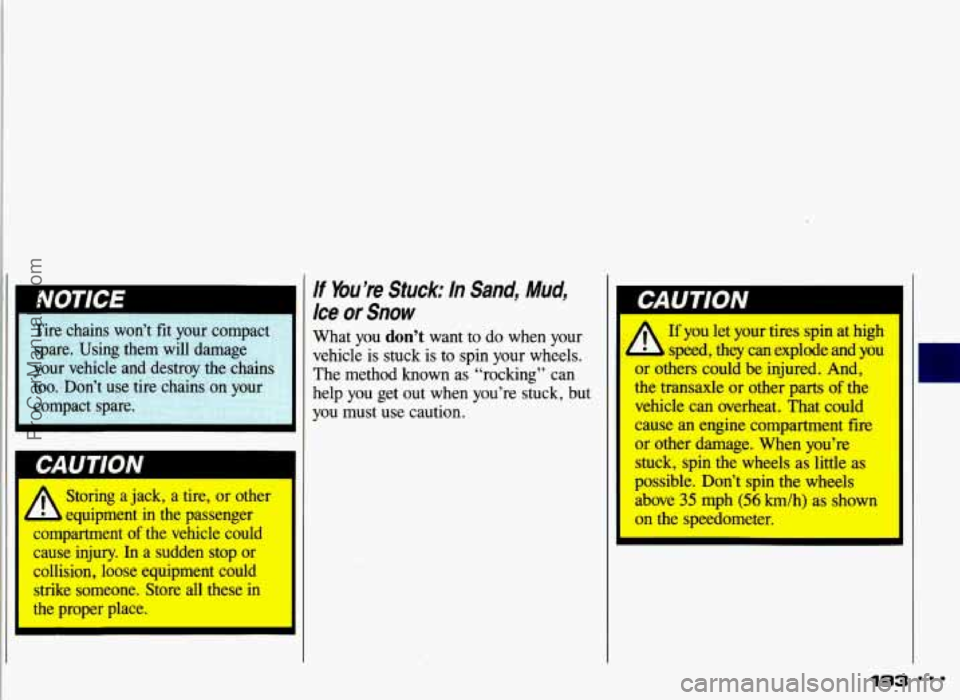
-
Tire chains won’t fit your compact
spare. Using them will damage
your vehicle and destroy the chains
too. Don’t use tire chains
on your
compact spare.
A Storing a jack, a tire, or other
- equipment in the passenger
compartment
of the vehicle could
cause injury.
In a sudden stop or
collision, loose equipment could
strike someone. Store
all these in
the proper place.
If You’re Stuck: In Sand, Mud,
Ice or Snow
What you don’t want to do when your
vehicle is stuck is to spin your wheels.
The method known as “rocking” can
help
you get out when you’re stuck, but
you must use caution.
CAUTION I
A
If you let your tires spin at high
speed, they can explode and you
or others could be injured.
And,
the transaxle or other parts of the
vehicle can overheat. That could
cause an engine compartment fire
or other damage. When you’re
stuck, spin the.wheels as little as
possible. Don’t spin the wheels
above
35 mph (56 km/h) as shown
on the speedometer.
193
ProCarManuals.com
Page 222 of 306

Engine Coolant
The following explains your cooling system and how to add coolant when it
is low. If you have a problem with
engine overheating, see the
Index under
Engine Overheating.
The proper coolant for your Pontiac
will:
Give freezing protection down to
Give boiling protection up to 262°F
Protect against rust and corrosion.
Help keep the proper engine
-34°F (-37°C).
(128°C).
temperature.
Let the warning
should. lights work as they
What to Use:
Use
a mixture of one-half clean water
(preferably distilled) and one-half
antifreeze that meets
“GM Specification
1825-M,” which won’t damage
aluminum parts. You can
also use a
recycled coolant conforming to GM
Specification 1825-M with a complete
coolant flush and refill. If you use this
mixture, you don’t need to add anything
else.
CAUTION I
A Adding only plain water ta
L pur cooling system can be
dangerous. Plain water, or some
other liquid like alcohol, can boil
bebe the proper coolant mix will.
system is set for the proper coolant
mix. With plain water or the
wrong mix, your engine could get
too hot but you wouldn’t get the
overheat warning, Your engine
could catch fire and you or others
could be burned. Use a 50/50 mix
of clean water and a proper
antifreeze.
Your v&hicle’s coolant warning
221 .
ProCarManuals.com
Page 223 of 306
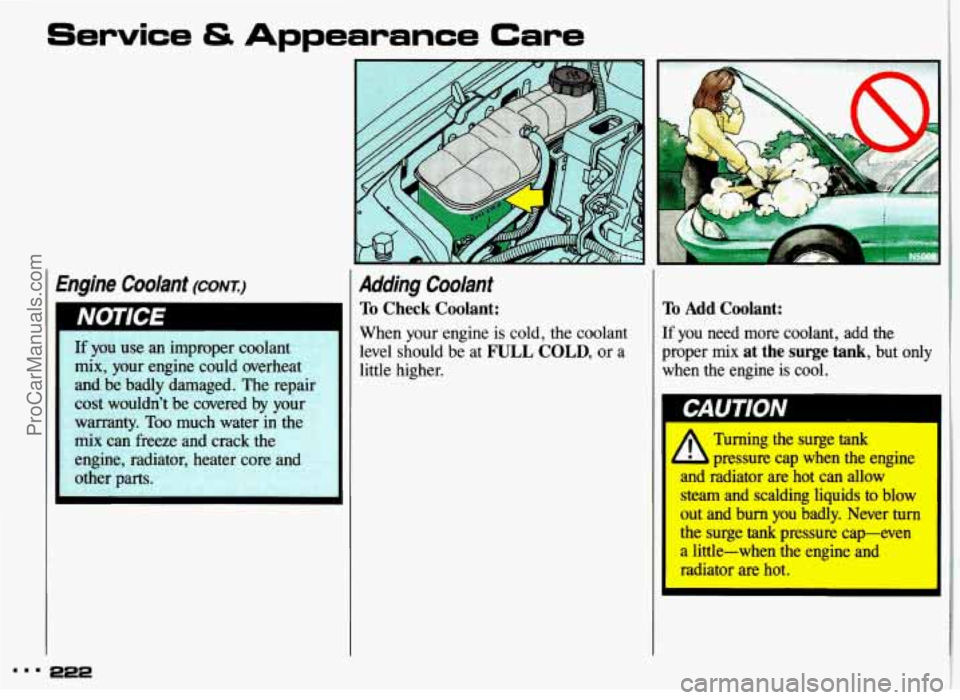
Service & Appearance Care
I Engine Coolant (CONI)
If you use an improper coolant
mix, your engine could overheat
and be badly damaged. The reDair
cost wouldn’t be covered by
yo
warranty. Too much water in the
mix can freeze and crack the
engine, radiator, heater
c ; and
other parts.
Adding Coolant
To Check Coolant:
When your engine is cold, the coolant
level should be at
FULL COLD, or a
little higher.
3
To Add Coolant:
If you need more coolant, add the
proper
mix at the surge tank, but only
when the engine is cool.
II
Turning the surge tank
L pressure cap when the engine
and radiator are hot can allow
sbeam and scalding liquids to blow
out and burn you badly. Never turn
the surge tank pressure capieven
a little-when the engine and I
radiator are hot.
ProCarManuals.com
Page 296 of 306

Proper Mixture to Use ......... 221
Safety Warnings. About
........ .179. 181. 182. 183
Temperature Gage
............. 93
Temperature Warning Light ...... 92
Thermostat
.................. 223
Corrosion Protection
............ 246
Cruise Control
.................. 70
Cup Holders
................... 83
Curves. Driving
on .............. 136
Customer Assistance Information
. . 279
Daytime Running Lights
......... 75
Defects. Safety. Reporting Dead Battery: What to Do
........ 171
Defensive Driving
.............. 126
(see
Safety Defects)
Defogger. Rear Window .......... 105
Defogging Your Windows
.... .103. 105
Door Locks
.................... 45
Door. Remote Fuel Filler
......... 203
Downshifting
.............. .62. 152
Driver Position
.................. 18
Driving
....................... 121
AtNight
.............. ... 142 City
........................ 147
Controlling a Skid
............. 141
Defensively
.................. 126
Drunken
.................... 127
Freeway
.................... 148
Highway Hypnosis
............ 151
Hill and Mountain
............ 152
In a Foreign Country
.......... 202
In Fog, Mist and Haze ......... 146
In the Rain
.................. 144
Long Distance ................ 150
Loss of Control
............... 140
On Curves ................... 136
Passing
..................... 138
Skidding
.................... 141
Through Deep Standing Water
.... 55
Winter Driving
............... 156
With a Trailer
................ 164
Driving on
Snow or Ice .......... 156
Drunken Driving
............... 127
Easy-Entry Seat
................ 11
Electrical Equipment, Adding
............. .55, 107, 248
Emergencies, Braking
........... 135 Emergencies
on the
Road ......... 169
Emergencies. Steering in
......... 137
Emergency Starting
.............. 171
Emergency Towing
.............. 175
Engine Block Heater
......... .56, 213
Engine Coolant (see
CooZant)
Engine Coolant Temperature Warning
Engine Identification
........ .52. 247
Engine Oil
.................... 209
Additives
.................... 213
Checking
& Adding ........... 209
Disposing of Used Oil
.......... 214
Energy Conserving
............ 212
Filter
.................. .213. 257
Kind of Oil to Use ............. 210
Pressure Gage
................. 95
Warning Light
................ 93
When to Change .............. 213
Engine Overheating
............. 179
Engine Specifications
............ 256
Engine. Starting
................. 52
Automatic Transaxle
........... 53
Manual Transaxle
.............. 53
2.3L Quad 4 Engine
............ 53
3300
V6 Engine ............... 54
295
Light (see Coolant)
ProCarManuals.com